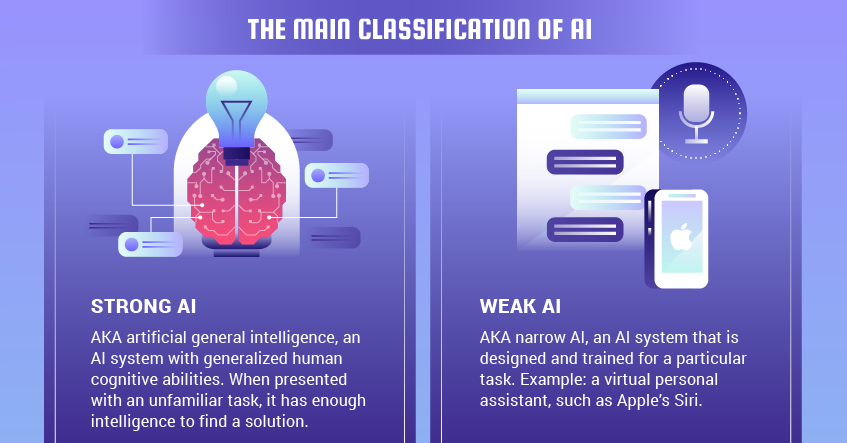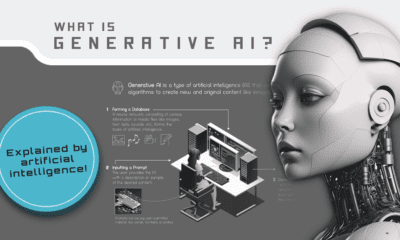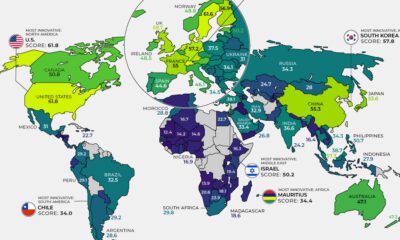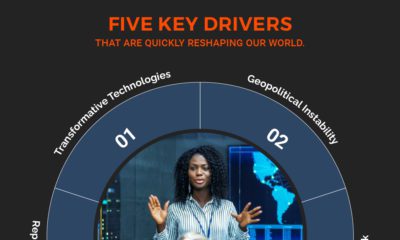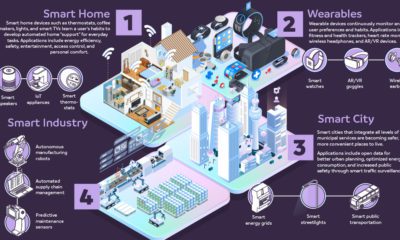Most people probably still envision AI in the form of a sentient robot that can talk, move around, and experience feelings – something like WALL-E or C-3PO from the movies. Although that still may be the dream, it turns out that the current iteration of AI is actually quite different. With modern AI, all the “thinking” gets done in the cloud, and the algorithms aren’t tied to the identity of a physical machine like we would have expected from the big screen. The modern iteration of AI works silently in the background without a face, and it’s starting to impact everything it touches. It’s also set to transform our economy at warp speed.
Putting Modern AI Into Context
Today’s infographic from TechJury helps you understand the context around this emerging force. Entitled “The AI Revolution”, it covers the brief history of AI, the industries that will be affected, as well as some key AI statistics that are likely to catch your eye.
Note: The infographic references a chatbot named Eugene Goostman that allegedly passed the Turing Test in 2014. Please note that this is a very contentious claim: while it did fool 33% of judges that it was a human, many experts object to the claim for a wide variety of reasons. Artificial intelligence is here and it’s transforming our economy. One estimate by PwC puts the global impact of AI at $15.7 trillion by 2030, while Accenture says that AI could double the rate of economic growth in developed countries by 2035. If either of these two predictions come true, it will mean big change for almost every industry.
The AI Revolution: By the Numbers
What does it look like when AI takes the world be storm? The following stats will give you an indication on the potential impact of the AI revolution, and how it’s already shaping the future of business thinking:
The number of AI startups has increased 14x since the year 2000 The amount of investment in AI startups has increased 6x since 2000 15% of enterprises in 2018 already use AI, but 31% more will come on board in the next 12 months 72% of executives see AI as being the most significant future business advantage 84% of global businesses see AI as providing a competitive advantage 41% of consumers believe AI will improve their lives in some way By 2020, businesses using AI to drive consumer insights will see $1.2 trillion more per year than their less-informed competitors
So while the AI revolution is not led by the identifiable face of a friendly (or antagonistic) robot in a physical form, experts agree that impact of AI on business will be profound. See how the prevailing myths about AI in the workplace have been debunked, to learn even more on the subject. on But fast forward to the end of last week, and SVB was shuttered by regulators after a panic-induced bank run. So, how exactly did this happen? We dig in below.
Road to a Bank Run
SVB and its customers generally thrived during the low interest rate era, but as rates rose, SVB found itself more exposed to risk than a typical bank. Even so, at the end of 2022, the bank’s balance sheet showed no cause for alarm.
As well, the bank was viewed positively in a number of places. Most Wall Street analyst ratings were overwhelmingly positive on the bank’s stock, and Forbes had just added the bank to its Financial All-Stars list. Outward signs of trouble emerged on Wednesday, March 8th, when SVB surprised investors with news that the bank needed to raise more than $2 billion to shore up its balance sheet. The reaction from prominent venture capitalists was not positive, with Coatue Management, Union Square Ventures, and Peter Thiel’s Founders Fund moving to limit exposure to the 40-year-old bank. The influence of these firms is believed to have added fuel to the fire, and a bank run ensued. Also influencing decision making was the fact that SVB had the highest percentage of uninsured domestic deposits of all big banks. These totaled nearly $152 billion, or about 97% of all deposits. By the end of the day, customers had tried to withdraw $42 billion in deposits.
What Triggered the SVB Collapse?
While the collapse of SVB took place over the course of 44 hours, its roots trace back to the early pandemic years. In 2021, U.S. venture capital-backed companies raised a record $330 billion—double the amount seen in 2020. At the time, interest rates were at rock-bottom levels to help buoy the economy. Matt Levine sums up the situation well: “When interest rates are low everywhere, a dollar in 20 years is about as good as a dollar today, so a startup whose business model is “we will lose money for a decade building artificial intelligence, and then rake in lots of money in the far future” sounds pretty good. When interest rates are higher, a dollar today is better than a dollar tomorrow, so investors want cash flows. When interest rates were low for a long time, and suddenly become high, all the money that was rushing to your customers is suddenly cut off.” Source: Pitchbook Why is this important? During this time, SVB received billions of dollars from these venture-backed clients. In one year alone, their deposits increased 100%. They took these funds and invested them in longer-term bonds. As a result, this created a dangerous trap as the company expected rates would remain low. During this time, SVB invested in bonds at the top of the market. As interest rates rose higher and bond prices declined, SVB started taking major losses on their long-term bond holdings.
Losses Fueling a Liquidity Crunch
When SVB reported its fourth quarter results in early 2023, Moody’s Investor Service, a credit rating agency took notice. In early March, it said that SVB was at high risk for a downgrade due to its significant unrealized losses. In response, SVB looked to sell $2 billion of its investments at a loss to help boost liquidity for its struggling balance sheet. Soon, more hedge funds and venture investors realized SVB could be on thin ice. Depositors withdrew funds in droves, spurring a liquidity squeeze and prompting California regulators and the FDIC to step in and shut down the bank.
What Happens Now?
While much of SVB’s activity was focused on the tech sector, the bank’s shocking collapse has rattled a financial sector that is already on edge.
The four biggest U.S. banks lost a combined $52 billion the day before the SVB collapse. On Friday, other banking stocks saw double-digit drops, including Signature Bank (-23%), First Republic (-15%), and Silvergate Capital (-11%).
Source: Morningstar Direct. *Represents March 9 data, trading halted on March 10.
When the dust settles, it’s hard to predict the ripple effects that will emerge from this dramatic event. For investors, the Secretary of the Treasury Janet Yellen announced confidence in the banking system remaining resilient, noting that regulators have the proper tools in response to the issue.
But others have seen trouble brewing as far back as 2020 (or earlier) when commercial banking assets were skyrocketing and banks were buying bonds when rates were low.

